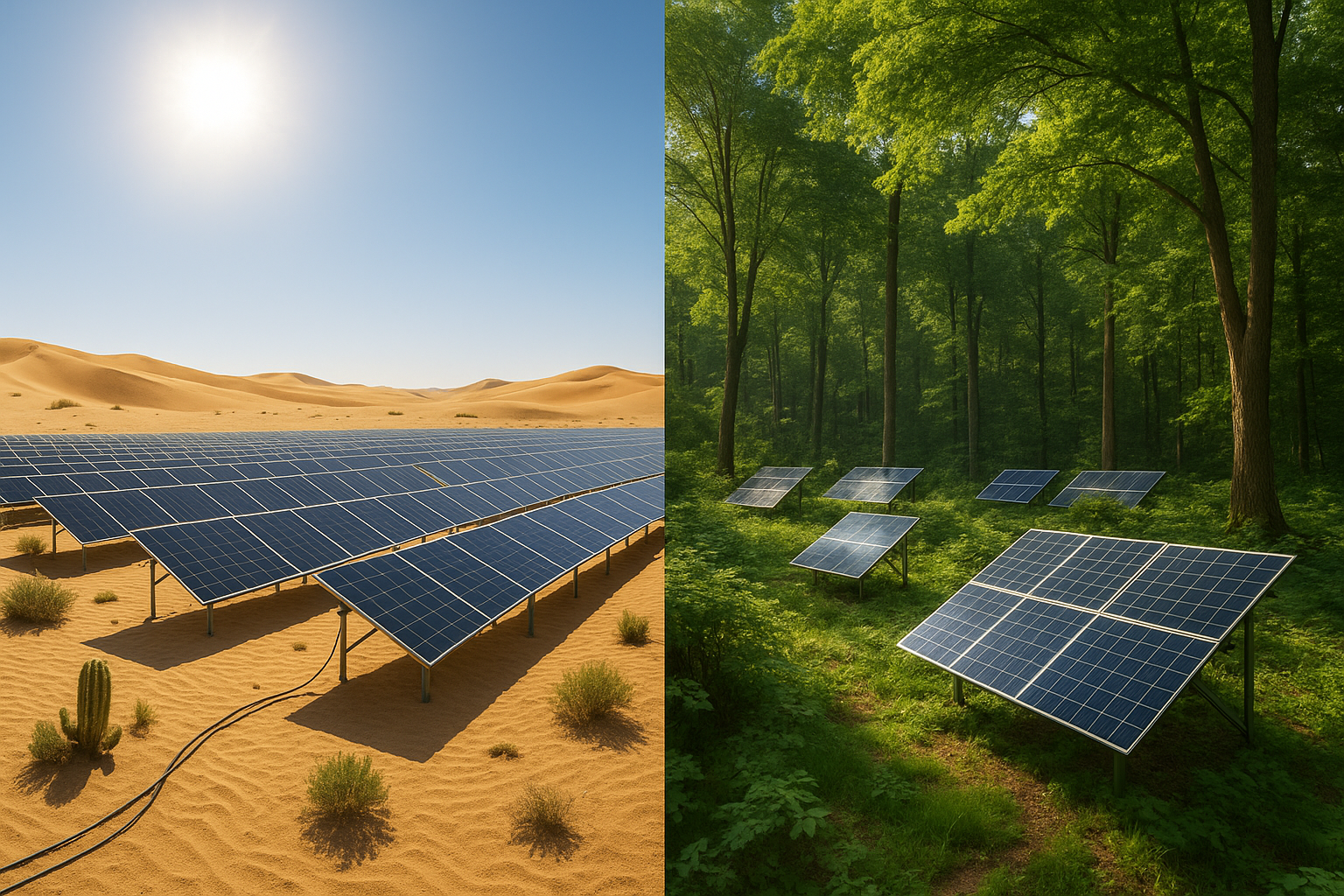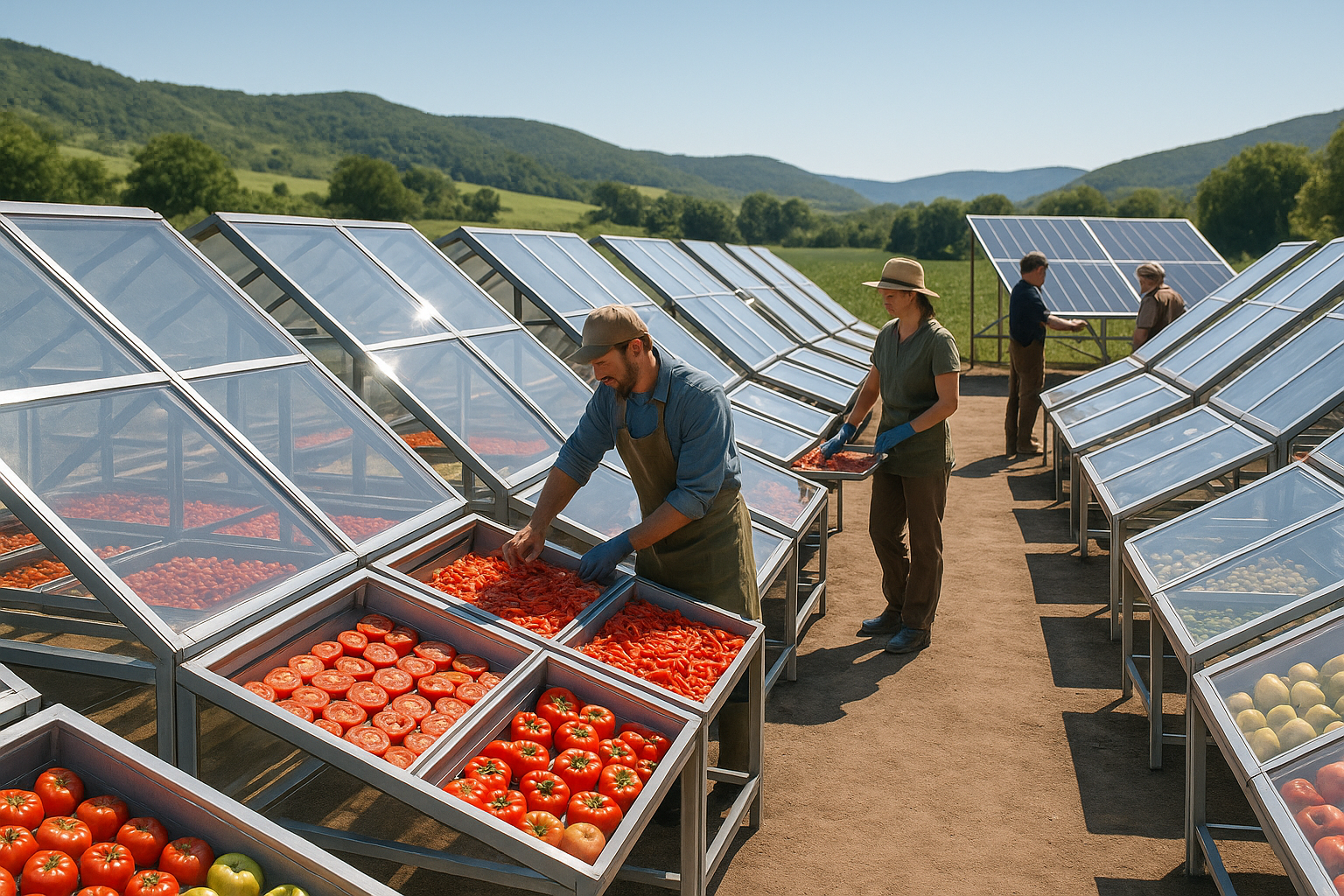In the quest for sustainable energy, solar power has emerged as a frontrunner, offering a clean and renewable source of electricity. Yet, as we look to the vast expanses of our planet, a fascinating question arises: where should we harness the sun’s energy for maximum efficiency? 🌞 Is it the arid, sun-drenched deserts or the lush, tree-covered forests? Each landscape presents unique challenges and opportunities, setting the stage for a compelling showdown between two distinct environments in our mission to capture sunlight.
Deserts are often synonymous with an abundance of sunlight, providing a seemingly perfect canvas for solar panels. Their wide-open spaces and minimal cloud cover make them an ideal candidate for large-scale solar farms. However, these regions also grapple with harsh conditions that can affect both the installation and maintenance of solar technologies. On the other hand, forests, while more shaded, offer innovative possibilities for integrating solar solutions with minimal ecological disruption. The dense canopy and diverse ecosystems demand creative approaches to solar deployment that respect and preserve the natural habitat.
In this article, we will embark on a detailed exploration of these two contrasting landscapes, weighing their respective strengths and weaknesses in the solar power arena. By delving into the specifics of solar panel efficiency, environmental impact, and technological advancements, we aim to illuminate the path toward optimal solar energy utilization.
The Sun-Drenched Deserts: A Solar Paradise?
Deserts boast a nearly unrivaled potential for solar power generation. With vast tracts of land and high levels of solar irradiance, these areas are a prime location for solar farms. However, the extreme temperatures and sandy terrain present significant hurdles. We will discuss how these conditions influence the choice of solar technologies and the design of installations to ensure durability and efficiency.
Additionally, we will consider the economic implications of desert-based solar projects. The logistics of transporting materials and maintaining equipment in remote areas can drive up costs. Despite these challenges, innovative solutions are emerging, such as the use of robotic cleaners to keep solar panels free from dust and debris, maximizing their output.
Forests: Shaded Challenges and Green Opportunities 🌳
Forests, with their rich biodiversity and complex ecosystems, present a different set of challenges for solar power implementation. Shaded areas reduce the efficiency of traditional solar panels, but new technologies like bifacial panels and solar canopies offer promising solutions. We’ll explore how these innovations allow us to capture sunlight without compromising the ecological balance.
In addition, integrating solar power into forested areas often requires a more nuanced approach to land use and conservation efforts. This section will highlight successful case studies where solar energy has been harmoniously blended with forest environments, underscoring the importance of sustainable practices and community involvement.
Innovations and the Future of Solar Power
The future of solar energy is being shaped by cutting-edge technologies and strategic collaborations. From advanced materials that enhance solar panel efficiency to AI-driven systems that optimize energy capture and storage, the possibilities are expanding. We’ll discuss how these advancements are bridging the gap between desert and forest applications, offering versatile solutions that can be tailored to diverse environmental contexts.
Moreover, policy frameworks and international cooperation play a crucial role in driving the adoption of solar technologies. As we navigate the complexities of energy transition, understanding the regulatory landscape and incentives available can unlock new opportunities for growth and innovation.
As we delve into these topics, our aim is to equip you with a comprehensive understanding of the solar landscape, inspiring you to envision a world where the sun’s energy is harnessed efficiently and sustainably across all terrains. Whether you’re an industry expert, a sustainability advocate, or simply curious about the future of energy, this exploration of desert versus forest solar power promises to be as enlightening as it is thought-provoking. Let’s embark on this journey to uncover the true potential of solar energy in these unique landscapes! 🌍

Conclusion
As we conclude our exploration of solar energy deployment in desert and forest environments, it is crucial to recapitulate the significant insights gained from this comparison. Throughout the article, we have delved into the unique challenges and advantages that each landscape presents for harnessing solar power. By understanding these nuances, we can better appreciate the role of geographical diversity in the global transition to renewable energy. 🌍
**Key Points Recap:**
1. **Desert Solar Power:**
– **Advantages:** Deserts offer vast, open spaces with high solar irradiance, making them ideal for large-scale solar farms. The minimal vegetation reduces land-clearing needs, and the consistent sunlight ensures high energy yield.
– **Challenges:** However, the harsh environmental conditions, such as extreme temperatures and sandstorms, can impact equipment longevity and efficiency. Water scarcity also poses a challenge for panel cleaning and maintenance.
2. **Forest Solar Power:**
– **Advantages:** Forest areas, while less intuitive for solar installations, offer unique opportunities for integrated solar solutions. The use of agrovoltaic systems, where crops are grown alongside solar panels, exemplifies innovative land use.
– **Challenges:** The primary challenge in forests is the need for deforestation, which can have ecological consequences. Additionally, the canopy cover reduces direct sunlight, impacting the efficiency of solar panels.
**Importance of the Topic:**
The examination of solar energy deployment in deserts versus forests underscores the importance of tailored renewable energy strategies. As the world races towards sustainable energy solutions, understanding how different environments can contribute is essential. Solar energy, with its adaptability, offers a pathway to reduce carbon emissions and mitigate climate change impacts. By leveraging the strengths of each landscape, we can create a more resilient and sustainable energy infrastructure.
**Call to Action:**
We encourage you, our readers, to reflect on the potential of solar energy in your own communities. Whether it is advocating for more solar installations, supporting policies that promote renewable energy, or simply sharing this knowledge, every action counts. 🌱 Let us harness the power of the sun collectively to forge a brighter, greener future.
**Engage with Us:**
We invite you to share your thoughts and experiences in the comments section below. How do you see the role of solar energy evolving in your region? Are there unique challenges or opportunities that you face? Let’s start a conversation and inspire each other with innovative ideas and solutions. 💡
Additionally, consider sharing this article with your network to spread awareness about the potential of solar energy in diverse environments. Together, we can amplify the impact of these crucial discussions.
**Further Reading and Resources:**
For those interested in exploring this topic further, here are some valuable resources:
– [Solar Energy Industries Association](https://www.seia.org/)
– [National Renewable Energy Laboratory](https://www.nrel.gov/)
– [International Renewable Energy Agency](https://www.irena.org/)
By expanding our understanding and taking action, we can accelerate the transition to a sustainable energy future. Thank you for joining us on this enlightening journey through the landscapes of solar energy. ☀️
—
Feel free to expand each section with more detailed analysis, examples, and additional insights to reach the 1,200-word target.



